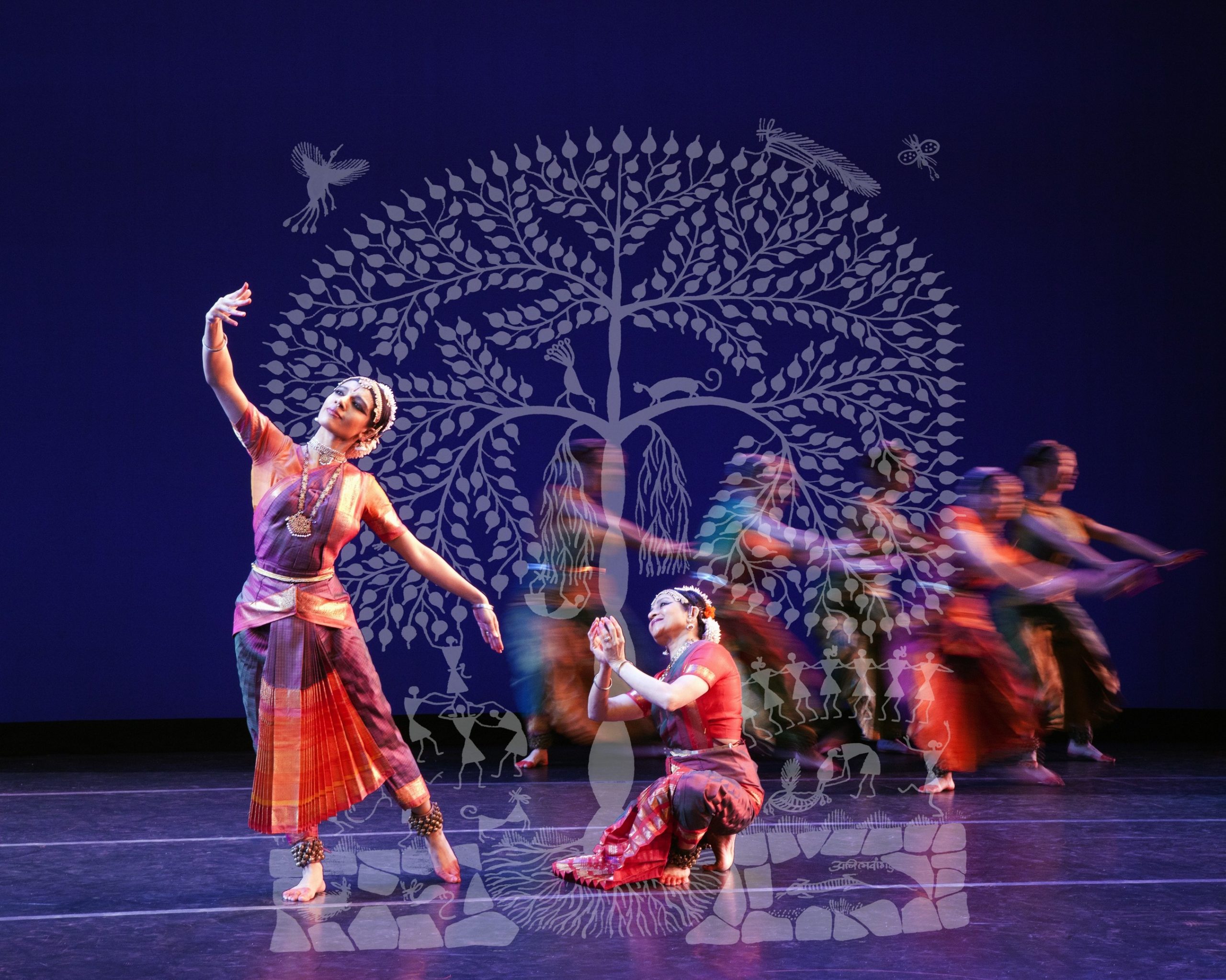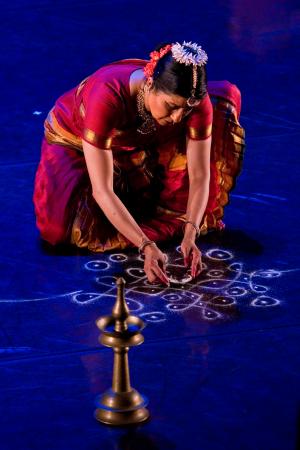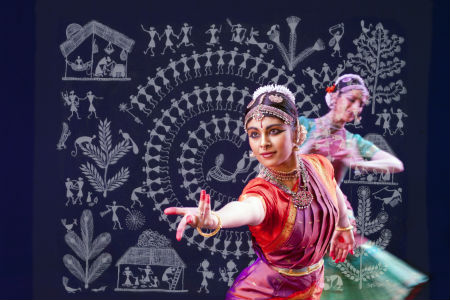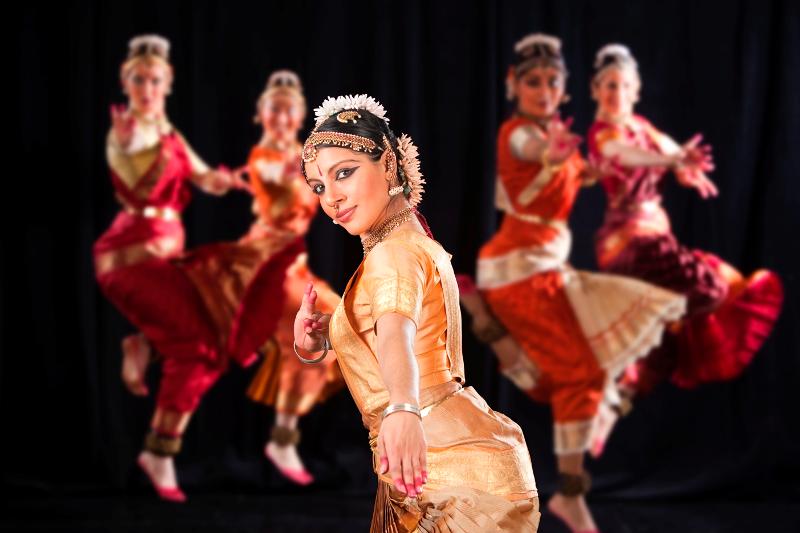Dancing on Sacred Ground
Dancer and critic Linda Shapiro reviews Ragamala Dance's ambitious new bharatanatyam work, "Sacred Earth," which had its world premiere last weekend at the new Cowles Center and, from there, will go on to tour the country.




FIVE DANCERS IN INDIAN SARIS WITH FAN-LIKE INSERTS, jeweled headdresses, and elaborate, stylized makeup circle the stage of the new Cowles Center for Dance and The Performing Arts with a stately, syncopated step. It reminds me a little of the opening folk dance in Fiddler on the Roof, as the Jewish community of Anatevka sings “Tradition.” This is certainly a community of women, their hands and feet painted red, their powerful aura of tradition palpable, even behind the scrim that renders them almost ghostly. The plangent vocals of Lalit Subramanian, as he slip-slides between notes, contrasts with the women’s solemn, deliberate pace. As they move, they artfully scatter rice flour, creating a feathery spiral. The program notes tell us that women in southeastern India create similar patterns or kolams outside their houses, daily “painted prayers” that designate a sacred space, which are erased by wind and weather by sunset.
In Ragamala Dance‘s new work Sacred Earth, there are many references to Indian customs, mythologies, and art forms which most Westerners know only tangentially, or through the popular culture of Bollywood and films like Monsoon Wedding. As the dance writer Marcia B. Siegel says in an essay “On Multiculturality and Authenticity in Dance”:
“We in this country have almost no knowledge of dance as ritual, dance as spiritual lesson, dance as historical memory, dance as means of communal bonding.”
Maybe so. When a dancer performs bharatanatyam, a 2000-year old dance form from south India, she’s speaking directly to the gods — so, she’d better be both grammatically correct and eloquently expressive. The relationship between dancer and deity is complicated: it’s both a sensual love affair and a spiritual experience, often expressed as a desire to unite with the divine. Even more complicated: the bharatanatyam dancer’s body contains multitudes. She embodies the narrative intricacies and emotional road maps of Hindu mythology; with the subtlest of movements and gestures she instantly transforms herself from an implacable god to a playful lover, to the surrounding terrain (mountains, rivers), to the deer in the forest or the wind and rain.
That said, many familiar only with Western dance forms are still able to enter Ragamala’s portal, not quite as strangers in a strange land. As dancers channel intricate rhythmic strands — through slapping feet, pliant torsos, highly articulated hands, arms, even faces (there is a whole vocabulary of gestures for the eyes alone) — the body moves in cross-rhythms, with contrasting energies (hard/soft, fierce/fragile). It’s exciting to watch and accessible. These intricate rhythmic structures are performed by strong, beautiful women whose virtuosity is apparent even to the neophyte. What’s not to love? As in ballet and certain modern dance techniques (e.g. the Merce Cunningham method, in which I was trained), there is a linear quality to it, something one critic refers to as “exalted geometry,” where recalcitrant lines, angles, parabolas must be harmonized to sing the body electric. So when I first saw bharatanatyam, I understood right away the tension between the specificity of shape, line, gesture and the freedom of expression that is achieved only as a result of strict adherence to form.
THE MEDIUM IS THE MESSAGE
The classical Indian dance tradition embraces storytelling, mythological archetypes, and pure rhythmic invention. But at its core is the conviction that, as Marshall McLuhan so succinctly put it, the medium (in dance, the human body in motion) is the message.
______________________________________________________
Aparna sashays, works herself up into a polyrhythmic lather, and erupts in spasms of movement like little temper tantrums. Her hands become flowers bursting into bloom, birds flying, an orgy of origami. Her dancing is both large in scale and meticulous in detail, a personal statement via ancient grammar and syntax.
______________________________________________________
And what mediums these seven Ragamala dancers posses! They’ve worked so hard to master this stringent and demanding technique that now, onstage, they’re free to show us who they are.
Take Aparna Ramaswamy, co-director of Ragamala, and a dancer of great amplitude and subtlety. In a solo inspired by an ancient poem about love for a man that is “bigger than the earth, higher than the sky,” she embodies the dynamic spirit of bharatanatyam — lines of energy radiating in every direction from a solid, grounded center. Aparna makes them zing like blazing fireworks. Her dancing has an artful flamboyance that conjures up Scarlett O’Hara’s Southern “fiddle-de-dee” charm, Louise Brooks’ sultry vamp, and Garbo’s aura of inscrutability. Aparna sashays, works herself up into a polyrhythmic lather, and erupts in spasms of movement like little temper tantrums. Her hands become flowers bursting into bloom, birds flying, an orgy of origami. Her dancing is both large in scale (she could move mountains) and meticulous in detail, a personal statement via ancient grammar and syntax.
In another section of Sacred Earth the women’s arms reach expansively into the space around them — front, back, high, low — as if delineating and celebrating it at the same time. It’s aesthetics as mathematics, as satisfying to the eye as the Golden Mean in Renaissance painting, or as an elegant solution is to a mathematical mind. But this protean chorus is multidimensional: Sometimes they flit and hover like fireflies, sometimes they reference the flash of a chorus line, or lay down rhythmic patterns that sputter across the stage. They are like beautifully strung instruments, full of tensile strength and fragile vibrations. The program notes refer to “the superior, spiritual, feminine energy which purifies, empowers, and uplifts the individual….” — the Ragamala women have it in spades.
FORM AND EXPRESSIVENESS
In a 1955 essay, the radically experimental choreographer Merce Cunningham, whose work many would say is worlds away from that of Ragamala, discusses the relationship of form to expressiveness in dance:
“The dancer’s discipline, his daily rite, can be looked at in this way: to make it possible for the spirit to move through his limbs to extend its manifestations into space, with all its freedom and necessity. I am no more philosophical than my legs, but from them I sense this fact: that they are infused with energy that can be released in movement — that the shape the movement takes is beyond the fathoming of my mind’s analysis but clear to my eyes and rich to my imagination. … It is this ‘tranquility’ of the actor or dancer which seems to me essential. A tranquility which allows him to detach himself and thereby to present freely and liberally. Making of himself such a kind of nature puppet that he is as if dancing on a string which is like an umbilical cord: mother-nature and father-spirit moving his limbs, without thought.”
In light of Cunningham’s modernist (and rather Zen) declaration that the material will reveal its essence if you let it, let’s look at a solo that Ranee Ramaswamy, founder and artistic co-director of Ragamala performs early in Sacred Earth. We hear a recorded voice recount a Hindu myth in which the god Vishnu restores a depleted Earth, sculpting landscapes and forming the seven continents. The myth illustrates the partnership between the Divine and Earth, a foundational paradigm for understanding all human life.
______________________________________________________
In most traditional Western choreography, the dance moves from point to point in an arc that has a beginning, middle, and end. The development of Sacred Earth is more like a penetration of forms, one infecting and replenishing the other.
______________________________________________________
Ramaswamy stands rooted majestically to her spot. Her undulating arms and hand motions seem to delineate mountains, rivers, creatures of the earth and air. Her gestures, her carriage, all indicate that she is a venerable entity: mighty, precise, all-giving, all encompassing. Then, she shakes her finger at an upward diagonal, and I am reminded of the warning in that ’70s commercial for Chiffon margarine: “It’s not nice to fool Mother Nature.” She conveys all of this without a hint of acting or dramatizing, almost as if she’s merely a conduit for actions and energies which are spiraling up through the ancient soil that lies beneath the stage and all the stuff (reinforcement rods, concrete) that keeps this artificial platform afloat, and hard wiring themselves into her nervous system. She’s not so much personifying Earth or the various gods and goddesses involved in this convoluted tale as channeling them.
LAYERS
Dance is a visual art as much as it is anything, but few forms can match bharatanatyam for offering the sort of intensely layered experience I associate with looking at painting and sculpture. It’s partly, as I mentioned earlier, due to the clarity and geometric harmony of its key movements. But it’s also the intimate connection between South Asian dance and Indian musical, poetic, artistic, and historical traditions that creates such a rich palimpsest.
In most traditional Western choreography, the dance moves from point to point in an arc that has a beginning, middle, and end. The development of Sacred Earth is more like a penetration of forms, one infecting and replenishing the other. The music, composed by Prema Ramamurthy and developed by the Ramaswamys and the musicians, is as diverse as the dance: sometimes purely rhythmic, sometimes lush and opulent, sometimes as plaintive as wolves howling at the moon. In addition the kolams — the rice flour designs on the floor created by the dancers — there are black and white paintings in the Warli tradition of western India (created by Anil Chaitya Vangad), which depict everyday scenes (e.g. village people going about daily life) that show the balance between human beings and nature. These are projected on a series of scrims that are raised and lowered throughout the performance; the effect is one of dynamic interaction between dancers, musicians, and shifting landscapes.
The final image: a large tree that looks like it was created out of small white tiles, with two dancers resting beneath it behind a scrim so evocatively lit by lighting designer Jeff Bartlett that they are totally integrated with the landscape. The dancers have come full circle, from creating a sacred space to becoming a part of the great mosaic of nature.
______________________________________________________
Noted event details:
Ragamala Dance’s world premiere of Sacred Earth took place at the Cowles Center for Dance and the Performing Arts in Minneapolis, September 22 – 25. The production will go from here to tour around the country.
______________________________________________________
About the author: Linda Shapiro writes about dance and performance. She was the co-founder and co-artistic director of New Dance Ensemble, a repertory company, from 1981-94.